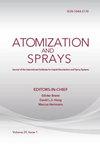Planar two-photon fluorescence imaging of dense spray to estimate spray characteristics: application in pressure-swirl atomizers
IF 0.9
4区 工程技术
Q4 ENGINEERING, CHEMICAL
引用次数: 0
Abstract
The dense spray produced at the primary stage of atomization in a pressure-swirl atomizer is characterized in this work. The optically dense regime from continuous liquid stream to first step breakup into liquid structures is acquired using a two-photon planar laser-induced fluorescence (2p-PLIF) technique. A notable advantage of 2p-PLIF over conventional PLIF is the attenuation of multiple scattering by simultaneous absorption of two photons in an ultra-short pulse duration. This approach is able to capture the complex interface morphology of spray structures. A curvature-based analysis of near-field is carried out to predict far-field spray characteristics. This methodology was recently introduced by \cite{Palanti2022} to investigate numerical simulation of atomizing liquid flows. The present work extends its application to experimental images. The atomization process is described through the curvature distribution in different regimes. The spray characteristics are predicted from the early stage of atomization and are reasonably comparable with those of direct measurement by Phase Doppler Anemometry (PDA) in the later stage of atomization. The present analysis shows how it is possible to obtain information about the dispersed phase of the spray in advance based on the dense spray curvature distribution.对密集喷雾进行平面双光子荧光成像以估计喷雾特性:在压力漩涡雾化器中的应用
本研究对压力漩涡式雾化器在雾化初级阶段产生的致密喷雾进行了表征。采用双光子平面激光诱导荧光(2p-PLIF)技术获取了从连续液流到第一步液体结构破裂的光学致密过程。与传统的 PLIF 相比,2p-PLIF 的一个显著优势是通过在超短脉冲时间内同时吸收两个光子来衰减多重散射。这种方法能够捕捉到喷雾结构复杂的界面形态。通过对近场进行基于曲率的分析,可以预测远场喷雾特性。最近,Palanti 2022 提出了这种方法来研究雾化液体流的数值模拟。本研究将其应用扩展到实验图像。雾化过程是通过不同状态下的曲率分布来描述的。从雾化的早期阶段开始预测喷雾特性,并在雾化的后期阶段与相位多普勒风速仪(PDA)的直接测量结果进行合理比较。本分析表明了如何根据密集喷雾曲率分布提前获得喷雾分散相的信息。
本文章由计算机程序翻译,如有差异,请以英文原文为准。
求助全文
约1分钟内获得全文
求助全文
来源期刊

Atomization and Sprays
工程技术-材料科学:综合
CiteScore
2.10
自引率
16.70%
发文量
54
审稿时长
1.7 months
期刊介绍:
The application and utilization of sprays is not new, and in modern society, it is extensive enough that almost every industry and household uses some form of sprays. What is new is an increasing scientific interest in atomization - the need to understand the physical structure of liquids under conditions of higher shear rates and interaction with gaseous flow. This need is being met with the publication of Atomization and Sprays, an authoritative, international journal presenting high quality research, applications, and review papers.
 求助内容:
求助内容: 应助结果提醒方式:
应助结果提醒方式:


